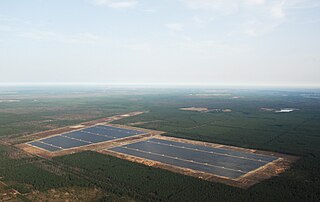
The Waldpolenz Solar Park is a 52-megawatt (MW) photovoltaic power station built by German developer and operator Juwi at a former military air base near Leipzig, Eastern Germany. When completed by the end of 2008, it was the world's largest thin-film solar park using CdTe-modules.

Alamosa Photovoltaic Power Plant, is a 7.7 MWAC (8.2 MWp) photovoltaic power station located in San Luis Valley, Colorado. The facility was the largest in the United States to service a major public utility when its activation was announced on December 17, 2007. It was the second largest plant after the U.S. Air Force's Nellis Solar Power Plant which was inaugurated the same day. The electricity is being sold to Public Service of Colorado, a subsidiary of Xcel Energy, under a 20-year power purchase agreement.

Solon SE was a German solar energy company with headquarters in Berlin. Solon SE produced photovoltaic modules at its production sites in Greifswald, Steinach in Tirol, Carmignano di Brenta, Tucson and Berlin. Solon also offered turn-key solar power plants, projected by SOLON Inverstments and Inverters, developed and produced by SOLON Inverters AG.
The Davidson County Solar Farm is a 17.2 megawatt solar power station located in the heart of North Carolina, near the community of Linwood. SunEdison built the array of photovoltaic panels, and Duke Energy buys all the output from the solar farm. The solar farm is located on North Carolina Highway 47, off New Jersey Church Road.

The Lieberose Photovoltaic Park is a 70.8-megawatt (MW) photovoltaic power plant in Lieberose, Brandenburg, Germany. The solar park with 900,000 solar panels which went fully on line in October 2009, and will supply electricity for 15,000 households a year while reducing the use of pollution-generating fossil fuels. The Lieberose Solar Park cost $238-million and is operated by the Juwi Group, which has a 20-year contract on the land.
The Köthen Solar Park is a photovoltaic power station in Köthen, Germany. It has a capacity of 45 megawatts (MW) and an expected annual electricity generation of 42 gigawatt-hours. The solar park was developed and built by RGE Energy.
The Montalto di Castro photovoltaic power station is an 84 megawatt (MW) photovoltaic power station at Montalto di Castro in Viterbo province, Italy. The project was developed by the independent developer SunRay that was later acquired by SunPower. The park is the largest PV project in Italy, and among the largest in Europe.
The Rothenburg Solar Park is a photovoltaic power station in Rothenburg, Oberlausitz in Germany. Initially it had a capacity of 20.5 megawatts (MW). The solar park is equipped with 273,240 CdTe-modules from First Solar, and 11 Siemens central inverters. The project was commissioned in 2009. The original solar farm was divided into three fields on the airfield site.
The Gabardan Solar Park is a 67.5 megawatt (MW) photovoltaic power station in France. It has about 872,300 thin-film PV panels made by First Solar, and incorporates a 2 MW pilot plant using 11,100 solar trackers.
The Avenal Solar Facility is a 57.7 megawatt (MW) photovoltaic power station in Kings County, California, constructed using 450,900 SHARP-128W thin-film modules. At its completion, it was California's largest photovoltaic facility.

The Lauingen Energy Park is a 25.7–megawatt (MW) photovoltaic power station, located in Bavarian Swabia, Germany. It covers an area of 63 hectares and was commissioned in June 2010.
The Fürstenwalde Solar Park is a photovoltaic power station in Fürstenwalde, Germany. It has a capacity of 39.64 megawatt (MW) and an annual output of 36.5 GWh. The solar park was developed by the company Solarhybrid and built by conecon using 62,832 225-watt and 110,880 230-watt solar panels, both manufactured by Suntech.
The Solarpark Heideblick is a photovoltaic power station in Heideblick, Germany. It has a capacity of 27.5 megawatts (MW). The solar park was developed and built by Enerparc.
The following outline is provided as an overview of and topical guide to solar energy:

Solarpark Senftenberg/Schipkau is a 166 megawatt (MW) photovoltaic power station located in Germany near the border of Senftenberg and Schipkau. The plant was built on the now closed Meuro lignite mine and is the country's largest solar park. It was named POWER-GEN International solar project of the year in 2012.

Neuhardenberg Solar Park is a 145-megawatt (MW) photovoltaic power plant, and was Europe's largest solar power station, located at the former Neuhardenberg military airport in Brandenburg, Germany.

The Jännersdorf Solar Park is a photovoltaic power station in Prignitz, Germany. It has a capacity of 40.5 megawatts (MW) and an annual output of 38 GWh. The solar park was developed and built by Parabel AG.
Solar power in Chile is an increasingly important source of energy. Total installed photovoltaic (PV) capacity in Chile reached 8.36 GW in 2023. Solar energy provided 19.9% of national electricity generation in Chile in 2023, compared to less than 0.1% in 2013.
The Letsatsi Solar Park is a 75-megawatt (MW) solar photovoltaic power station in Bloemfontein, Free State, South Africa. The solar park uses 277,632 conventional, multicrystalline silicon PV solar panels and went fully on line in May 2014. Its annual generation will be about 150 gigawatt-hours, enough to supply electricity for about 50,000 to 60,000 homes, while reducing the use of pollution-generating fossil fuels. The Letsatsi Solar Park cost $487 million and is operated by the Letsatsi Solar Energy Ltd., which plans to operate the solar park for at least 20 years.
The Sagasolar Power Station is a solar photovoltaic power station built next to the Hambantota Solar Power Station, in Hambantota, Sri Lanka. The solar farm is owned and developed by Sagasolar, a joint venture between LOLC Group and Faber Capital Limited, with 70% debt funded by DFCC Bank, Commercial Bank of Ceylon, and Hatton National Bank. The 10-megawatt facility is expected to generate approximately 19GWh annually for at least 25 years.










